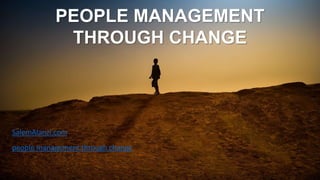
PEOPLE MANAGEMENT THROUGH CHANGE
- 1. PEOPLE MANAGEMENT THROUGH CHANGE people management through change SalemAlanzi.com
- 3. “Business conditions change and yesterday’s assumptions and practices no longer work”. (Charron, Harrington, Voehl, & Wiggin, 2014, p. 436) “implementing change is a very difficult task” (Waddell & Sohal, 1998) “change initiatives do not fail because of lack of grand visions or designs: they fail because leaders do not understand the complexities they are facing” (Karp & Helgø, 2009)
- 4. Kurt Lewin’s Force-Field Theory two sets of forces (the drivers for change and the resistance to change). Those forces are opposition to each other. The state of inertia where the two forces are in balance
- 5. Resistance to change “a force that slows or stops movement” (Maurer, 1996) “deviant behavior that needs to be cured” (Sharma, 2006, p. 88) “resistance is opposition or withholding of support for specific plans or ideas.” (O′Connor, 1993) “use resistance to build support for change” (Sharma, 2006, p. 88) “resistance plays a crucial role indrawing attention to aspects of change that may be inappropriate” (Waddell & Sohal, 1998)
- 7. The five stages of grief
- 8. Factors Causing Resistance to change not accepting the need for change not understanding the need for change not accepting the objects of the change not accepting the achievability of the change not accepting the implantation methodology of the change
- 9. implementation of the change “must avoid any overreaction to resistance once it is discovered” (O′Connor, 1993)
- 10. Kotter Eight-Stage Change Process Establishing a sense of urgency Creating the guiding coalition Developing a vision and strategy Communicating the change vision Empowering broad-based action Generating short-term wins Consolidating gains and producing more change: Anchoring new approaches in the culture
- 11. ADKAR model
- 12. the Burke-Litwin Change Model 1.External Environment 2.Mission and Strategy 3.Leadership 4.Organizational Culture 5.Structure 6.Systems 7.Management Practices: 8.Work Unit Climate 9.Tasks and Skills 10.Individual Values and Needs 11.Motivation Level 12.Individual and Overall Performance
- 13. The leadership styles The coercive style The authoritative style The affiliative style Democratic Pacesetting Coaching
